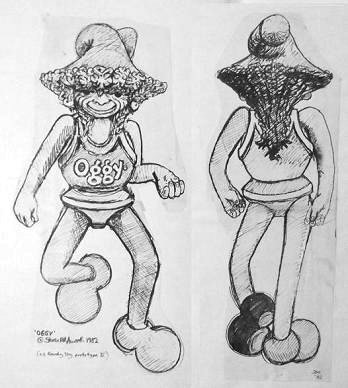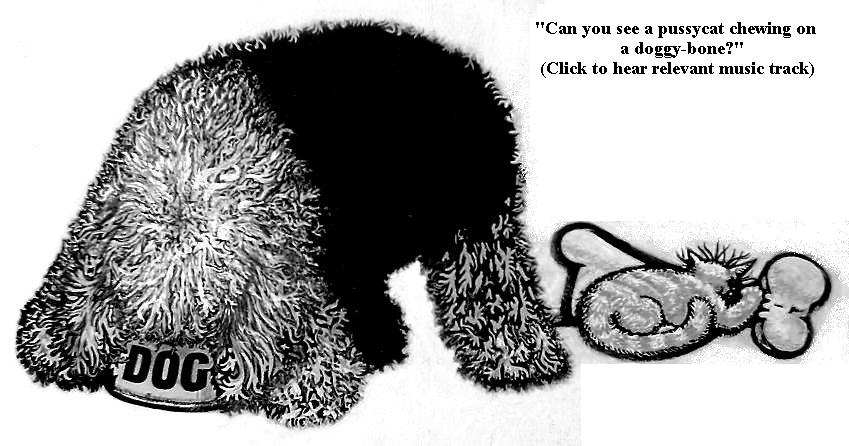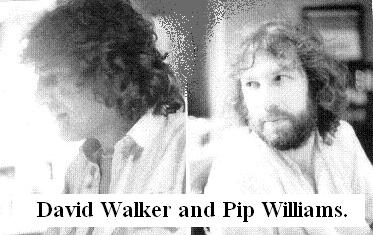|
Excerpt from the book: - "String" by Steven R. M. Acworth copyright 2006. Alternative title: - "Guitars to The Stars (The other side of the Screwdriver)" |
 |
|
Oggy Oggy Oggy! (an adventure into futility and a lesson in practicality). "you are far too ugly to ever be a star"... (David Walker, Handle Artists 1980) |
|||||
|
My adventures with The Oggy Band were the days of my stage keyboard playing. Apart from that, if you found me on stage at any other time, it would be playing guitar (naturally enough). The exception to that would be the time I spent playing fretless bass (my second favourite instrument to ukulele). The first of these periods was with The Ankh Band (a fairly miserable and thankless, unpaid task). The second occaision was in "Silver Quarter" - a seven piece show-band style combo that I gigged locally with around 2006. A truly fabulous band, sadly no more. Those gigs more than made up for all the previous dire nonsensical time-wasting bollocks through the 70's and 80's. If you were witness to any of that - so s-a-a-a-a-a-r-y is all... |
|||||
| In 1966, the name "Oggy Band" was coined by me in total ignorance of the existence of "Oggy" as a real word in common use. I thought I'd made it up. We couldn't understand why people shouted stuff like "Give us a pastie!", in Cornwall as we drove by in our bandwagon, conspicuously signwritten with the name. If we'd made it to Wales it would have been another story, again. We had a mascot, a little Oggy character doll (artist's impression to left, below), which I carved out of foam rubber and which eventually got lost by the wayside along the road somewhere - a bit like the much later, much more expensive version. This doll, though, just literally fell out of the van. | |||||
|
|||||
| Pip did just that (bought me the machine) and I soon began to practice with the Korg VC-10 machine I then got my grubby little mits on. Later we got a Roland 330 Vocoder Plus and the quality of diction was a lot clearer but among the first demos I made with the Korg were two songs, "Supermouse" (here a dreadful low-fi copy - and the original wasn't too clever) and "Maurice the Mole", no copy of which now exists in my possession. | |||||
|
The studio version of "The Rubber Band Song" was produced by Pip Williams (but I was left with a poor quality cassette copy only), along with another track for the Oggy Project, The Suburban Clog Dance. On Soundcloud this is labeled as "Vocoder Clog Dance" here represented more like the way it was supposed to sound, with full-on synth pulse and vocoder to the fore. As intended, there is no human voice mixed in, apart from Pip Williams' spoken count in and Kit Hain's rebel "Whoop!" at the fade. Bob Jenkins played drums (bless him). Original lyric here. This could have been a success but it wasn't broken - so between us, we fixed it anyway. The result was what was released on record and I hated with a vengeance: - "The Remixed Clog Dance" of which there have been many other versions recorded. Another one is here. The lyric was mostly changed too, completely away from the original which was considered too "over the top" even for the secretaries at Handle to handle. Moral? Stick to your guns. |
|||||
|
|||||
|
|||||
| "The Clog Dance" went through some strange manifestations of presentation. To begin with, Pip had invited me to his house to "routine" another song "The Kangaroo Hop" (here a later studio version), using his home tape machine - a Revox. I only had the germ of an idea for the rhythmic structure of the "Clog Dance" and no lyrics beyond a title. That rhythm went like this: - (sample). There was a copy of that strumming pattern on the cassette of Kangaroo Hop that I had with me. Pip's ears pricked up when the tape ran on and he asked me, "What is that?" | |||||
|
|||||
| The ideas were certainly coming thick and fast but the money wasn't. This was a time of no guitars at all in popular music. The synth was all we got to hear in the charts and my business as a guitar craftsman was teetering on the edge of an extinction event. The roof was falling in on my cottage and my wife and I were really struggling, even with the tiny mortgage we had. Getting the fare together for a taxi or even a train to London was difficult but I was being "Handled" by wealthy people. All that again. | |||||
|
Dreaming of a cult following and a string of hit records (of course), and completely blown away by the prescence of my rich and famous customers for my guitar technician services, I made a wrong turn. I thought that because they all met in the same studios and offices that I was working with some kind of team. The first demos I made on a friend's multitrack (Bob Suffolk - Fabulous Poodles), instead of being played to Pip Williams were played to Alan Crux (Quo's management) instead "Cruxie gonna be there soon" - the line from "Living on an Island". A genuine and innocent mistake but a resounding clanger, nonetheless. too. |
|||||
|
|||||
|
Work had virtually stopped on "The Rubber Band Song" as it dawned on David Walker and Pip Williams that we had the chance to build the beginnings of a substantial portfolio of potential hits. What wasn't understood by Handle Artists management was that I really hated the idea of mixing in my natural singing voice with the vocoder - to my ear the two sounds clashed badly. My fault? Wrong key - but how was I to know? Mixing vocoder with natural voice was totally foreign to me. And frankly, my dear, it didn't work. (more)... |
|||||
| The whole project seemed out of control. Nobody trusted my artistic judgement, constantly labeling my ideas as "over the top". That was the automatic knee-jerk reaction to anything I suggested. The safe and conservative choice was the only option as far as Handle were concerned but I knew that kids love the world of the weird and the strange. I was all for Oggy having flying saucers to mess about in (of course) and having just returned from a holiday in Crete was blown away by the Minoan civilization - a huge influence on my life for years to come. | |||||
|
|||||
|
Feelings were fraught in the Oggy camp and I was spending many hundreds of hours in the development of graphics, story lines and music, without any income. The guitar business was dead in the water and socially, for someone who was known to be rubbing shoulders with the stars, the situation was uncomfortable and it became embarrassing just to walk down the street. One day I spat out my dummy and walked out of the Mayfair office, throwing a hissy fit with the frustration of it all and had no contact with Handle for some months. When I returned, I had completely re-designed the main character and given him a new family. In the interim period, I'd tried to live with conventional employment for a while in my old trade (screen process printing) and realised that I could never do that all over again. That gave me the kick-start to put all my efforts back into Oggy to try to make it work. I presented Handle with the new corporate identity and they loved it. The new Oggy family lost its cat, "Fizzle" (my own real cat's nickname, "Debussy Cat" at the time), replaced with a small green dinosaur of the same name. The Old English Sheepdog (my Beethoven), "Grizzle" in the song, was left out of the plot entirely. |
|||||
|
|||||
| Once the newly designed family was accepted by Handle, David Walker approached the Bendy Toys company to get them involved in what seemed to be a viable childrens' T.V. animation series. Apparently a number of television companies were keen to assist the launch, notably the newly fledged Channel 4. Also an animation film company called Film Fair were approached, who had previously worked on the Wombles (remember this was a long time before C.G.I. was commonplace). I had a couple of meetings with their chief animation artist and, despite his portfolio work being proof of his genius, it lead us (and Oggy) nowhere at all. | |||||
|
|||||
|
|||||
|
I really thought we were starting to go somewhere when Bendy Toys came on board but the prototype they made from my first new drawings was simply hideous, in my opnion. It was an unoriginal stab at a "Disney-esque" dwarf. So my next move was to spend a few days with their sculptor to find out what I needed to give them in the way of a 3d model to mould from. |
|||||
|
|||||
|
When the Toy Fair Exhibition opened, it was my mission to go and see our hero on display at his "International launch". When I arrived at Earls Court Exhibition Centre, the toy fair was in full swing but Oggy wasn't. There was supposed to be a full-on display of dolls and graphics, with the animation company reps and T.V. people that I had been led to believe were all hot for it and were, for sure, all going to be there. No-one was there. There was one Oggy doll hanging on the corner of the Bendy Toys stand as though strung up from a gibbet. And nothing else. No information, no graphics and and no-one except the C.E.O. of Bendy Toys, looking mildly embarrassed. It gets worse... |
|||||
It was then revealed that the prototype demonstration model dolls that had been supplied to be promotional samples had been made in toxic plasic, totally unsuitable for distribution among record company executives' children. Dohh!!! There's co-ordination! |
|||||
|
To say I was pissed off is just wrong. It doesn't begin to express how bad I felt about the whole thing. At the time I was getting an ear-bashing from the ego maesters themselves and was close to a breakdown, I think, considering I now know exactly how that really goes. I tore back to the office and had a stand up blazing primal soul scream at David. Which made no impression at all. But he did close the door. In my frustration with the way everything had been going, in the meantime, I had previously asked Andy Scott of Sweet (also under Handle management at the time) to re-mix The Kangaroo Hop with me, using a Casio VL-Tone to overdub a kind of random twittering track. Random twittering just about sums up the whole episode. |
|||||
| Handle Artists David Walker had been holding out for more and more money from any prospective record company and in the death, formed his own: - the "Taurus" label. Now E.T. The Extra-terrestrial, was out and all attention turned in exactly that direction and away from any other commercial merchandidsing doll-type opportunities. I needed someone on my side and a valiant knight in shining armour arose from among my mates to say a few well chosen polite words on my behalf. At lunch with Benny Gallagher - who was also a good guitar playing customer of mine asked what was happening with Oggy. He didn't like what he heard at all. | |||||
| Benny kindly voluteered to meet with David Walker at Handle Artists to try to sort out what was going on. The deal I had been struggling with was restricting and prohibitive to anything else I wanted to do with my musical "career". Benny was riding high at the time as Simon and Garfunkel had just covered one of his songs in the U.S.A. and he quite simply told David that he was taking the piss and to let me go. | |||||
|
|||||
2,000 pressings of the 45 r.p.m. disc.
Probably not collectible!
|
|||||
|
Appendix to Oggy... When Pip had loaned me his Revox quarter-inch tape recorder in 1980, it meant that I could start learning a little bit about recording overdubs to my own stuff for the first time since the days of two old Grundig machines that I used to record stuff with Peter Frampton, as a 14 year old schoolkid at my mum's place in Bromley in 1965. Peter was a pretty hot guitarist even then. While we were messing about with tape recorders, bouncing tracks between machines, I built him a 12 string acoustic. It was pretty crude with a half-inch square rod of mild steel running through the neck and heavy, of course - but quite playable. |
|||||
|
Also rescued from a fifth-generation cassette tape is another example of this period of output, was when a long term customer and buddy, Steve Prior, now Steve Jay (Facebook), came over for some adjustments to his bass and I got him to squawk nastiness onto a spoof punk rock track I had put some backing together for. His particular blend of throat-gravel was purrrfect for the nonsense I was trying to squish out into the world of brow-beaten and severely troubled musical ether... Offensive and obviously meant at some stage... |
|||||
| Into that space I had always hoped to inject some of my straight rhythm guitar playing as I knew that was my strongest asset. My singing voice has never been particularly good but it seems to work for some people in jingles, particularly (more on that later). The first major problem I encountered once equipped with overdubbing facilities (a la Les Paul), was that goddamned temptation to overstuff the turkey. For example, this guitar piece is the basis of a song concept called "Festival". When I first attempted to produce a synthesized version with multiple instruments, I got this mess of "fizz". Strings are my thing, not keyboards. Learn, you fool! | |||||
|
For me to be in any way lively and agile on a keyboard, I am really forced to be quite content to do it the way I know I can be in complete control - and that is by losing the keyboard completely and instead, programming the exact number of the beast: - I speak'um fluent MIDI language, just as long as you are talking 96 clocks per crotchet. (Non technical minds look away now). That is, I never saw any point going any finer than that. The Yamaha QY20 was my bosom buddy for several years and it was my "classroom in musical numbers". Here's a couple of pieces done entirely by keystrokes on a pocket calculator-sized computer sequencing lump of plastic and sand; the QY20. "Advice From The Wizard" - and "Overture", parts of a half-hour orchestral suite composed by midi numbers, mostly while out walking my dogs. Here, in mp3 format. |
|||||
|
The temptation is overwhelming to include here some other real bloopers: - the first one is of my own personal trophy capture and comes from a session I was asked to produce for a local Kentish "Hill-Billy" country singer (small 'c') and his wife, who liked to sing in unison octave, of all things. Yuchh! I managed to pull together some useable musicians to do his backing for a number of tracks for sale on cassette at his gigs. This was captured on a pocket dictaphone micro-cassette recorder from the monitors in the control room at the session. I call the track "Long John Shockingbrain". |
|||||
|
Another blooper here is in reference only in that it is an internationally known excercise in embarrassment, namely "The Troggs Tape". Seek it out. This version has been re-mixed rather tastefully, I thought. |
|||||
|
Excerpt from the book: - "String" by Steven R. M. Acworth copyright 2006. Alternative title: - "Guitars to The Stars" & "The other side of the Screwdriver". Oggy Oggy Oggy... |
|||||
   |

















